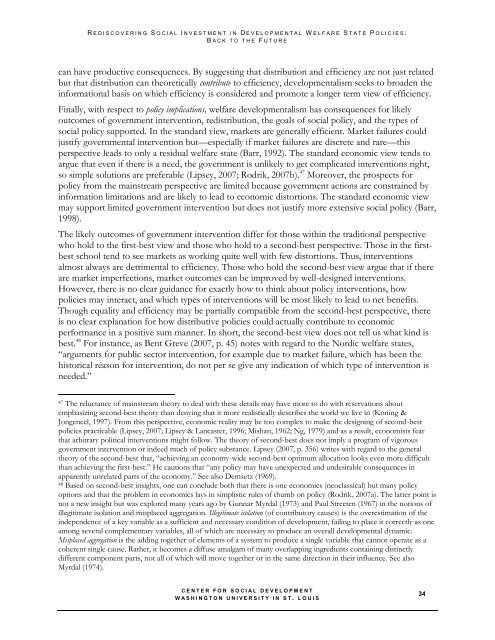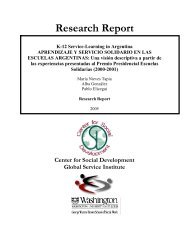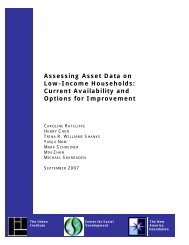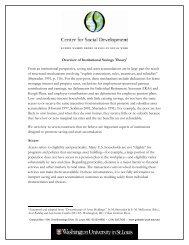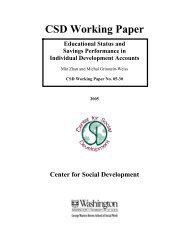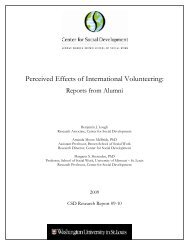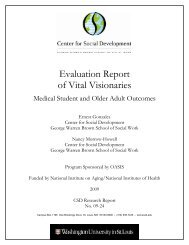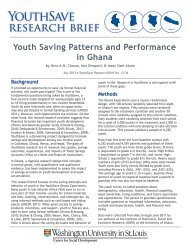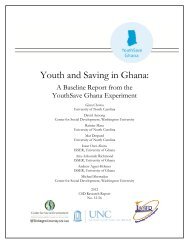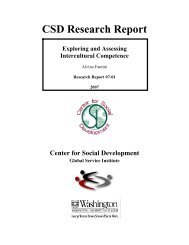Rediscovering social investment in developmental welfare state ...
Rediscovering social investment in developmental welfare state ...
Rediscovering social investment in developmental welfare state ...
Create successful ePaper yourself
Turn your PDF publications into a flip-book with our unique Google optimized e-Paper software.
R E D I S C O V E R I N G S O C I A L I N V E S T M E N T I N D E V E L O P M E N T A L W E L F A R E S T A T E P O L I C I E S :<br />
B A C K T O T H E F U T U R E<br />
can have productive consequences. By suggest<strong>in</strong>g that distribution and efficiency are not just related<br />
but that distribution can theoretically contribute to efficiency, <strong>developmental</strong>ism seeks to broaden the<br />
<strong>in</strong>formational basis on which efficiency is considered and promote a longer term view of efficiency.<br />
F<strong>in</strong>ally, with respect to policy implications, <strong>welfare</strong> <strong>developmental</strong>ism has consequences for likely<br />
outcomes of government <strong>in</strong>tervention, redistribution, the goals of <strong>social</strong> policy, and the types of<br />
<strong>social</strong> policy supported. In the standard view, markets are generally efficient. Market failures could<br />
justify governmental <strong>in</strong>tervention but—especially if market failures are discrete and rare—this<br />
perspective leads to only a residual <strong>welfare</strong> <strong>state</strong> (Barr, 1992). The standard economic view tends to<br />
argue that even if there is a need, the government is unlikely to get complicated <strong>in</strong>terventions right,<br />
so simple solutions are preferable (Lipsey, 2007; Rodrik, 2007b). 47 Moreover, the prospects for<br />
policy from the ma<strong>in</strong>stream perspective are limited because government actions are constra<strong>in</strong>ed by<br />
<strong>in</strong>formation limitations and are likely to lead to economic distortions. The standard economic view<br />
may support limited government <strong>in</strong>tervention but does not justify more extensive <strong>social</strong> policy (Barr,<br />
1998).<br />
The likely outcomes of government <strong>in</strong>tervention differ for those with<strong>in</strong> the traditional perspective<br />
who hold to the first-best view and those who hold to a second-best perspective. Those <strong>in</strong> the firstbest<br />
school tend to see markets as work<strong>in</strong>g quite well with few distortions. Thus, <strong>in</strong>terventions<br />
almost always are detrimental to efficiency. Those who hold the second-best view argue that if there<br />
are market imperfections, market outcomes can be improved by well-designed <strong>in</strong>terventions.<br />
However, there is no clear guidance for exactly how to th<strong>in</strong>k about policy <strong>in</strong>terventions, how<br />
policies may <strong>in</strong>teract, and which types of <strong>in</strong>terventions will be most likely to lead to net benefits.<br />
Though equality and efficiency may be partially compatible from the second-best perspective, there<br />
is no clear explanation for how distributive policies could actually contribute to economic<br />
performance <strong>in</strong> a positive sum manner. In short, the second-best view does not tell us what k<strong>in</strong>d is<br />
best. 48 For <strong>in</strong>stance, as Bent Greve (2007, p. 45) notes with regard to the Nordic <strong>welfare</strong> <strong>state</strong>s,<br />
―arguments for public sector <strong>in</strong>tervention, for example due to market failure, which has been the<br />
historical reason for <strong>in</strong>tervention, do not per se give any <strong>in</strong>dication of which type of <strong>in</strong>tervention is<br />
needed.‖<br />
47 The reluctance of ma<strong>in</strong>stream theory to deal with these details may have more to do with reservations about<br />
emphasiz<strong>in</strong>g second-best theory than deny<strong>in</strong>g that it more realistically describes the world we live <strong>in</strong> (Kon<strong>in</strong>g &<br />
Jongeneel, 1997). From this perspective, economic reality may be too complex to make the design<strong>in</strong>g of second-best<br />
policies practicable (Lipsey, 2007; Lipsey & Lancaster, 1996; Mishan, 1962; Ng, 1979) and as a result, economists fear<br />
that arbitrary political <strong>in</strong>terventions might follow. The theory of second-best does not imply a program of vigorous<br />
government <strong>in</strong>tervention or <strong>in</strong>deed much of policy substance. Lipsey (2007, p. 356) writes with regard to the general<br />
theory of the second-best that, ―achiev<strong>in</strong>g an economy-wide second-best optimum allocation looks even more difficult<br />
than achiev<strong>in</strong>g the first-best.‖ He cautions that ―any policy may have unexpected and undesirable consequences <strong>in</strong><br />
apparently unrelated parts of the economy.‖ See also Demsetz (1969).<br />
48 Based on second-best <strong>in</strong>sights, one can conclude both that there is one economics (neoclassical) but many policy<br />
options and that the problem <strong>in</strong> economics lays <strong>in</strong> simplistic rules of thumb on policy (Rodrik, 2007a). The latter po<strong>in</strong>t is<br />
not a new <strong>in</strong>sight but was explored many years ago by Gunnar Myrdal (1973) and Paul Streeten (1967) <strong>in</strong> the notions of<br />
illegitimate isolation and misplaced aggregation. Illegitimate isolation (of contributory causes) is the overestimation of the<br />
<strong>in</strong>dependence of a key variable as a sufficient and necessary condition of development, fail<strong>in</strong>g to place it correctly as one<br />
among several complementary variables, all of which are necessary to produce an overall <strong>developmental</strong> dynamic.<br />
Misplaced aggregation is the add<strong>in</strong>g together of elements of a system to produce a s<strong>in</strong>gle variable that cannot operate as a<br />
coherent s<strong>in</strong>gle cause. Rather, it becomes a diffuse amalgam of many overlapp<strong>in</strong>g <strong>in</strong>gredients conta<strong>in</strong><strong>in</strong>g dist<strong>in</strong>ctly<br />
different component parts, not all of which will move together or <strong>in</strong> the same direction <strong>in</strong> their <strong>in</strong>fluence. See also<br />
Myrdal (1974).<br />
C E N T E R F O R S O C I A L D E V E L O P M E N T<br />
W A S H I N G T O N U N I V E R S I T Y I N S T . L O U I S<br />
34


